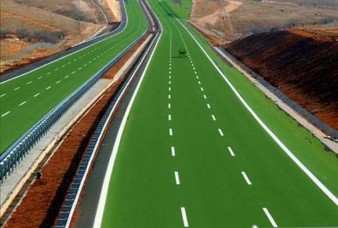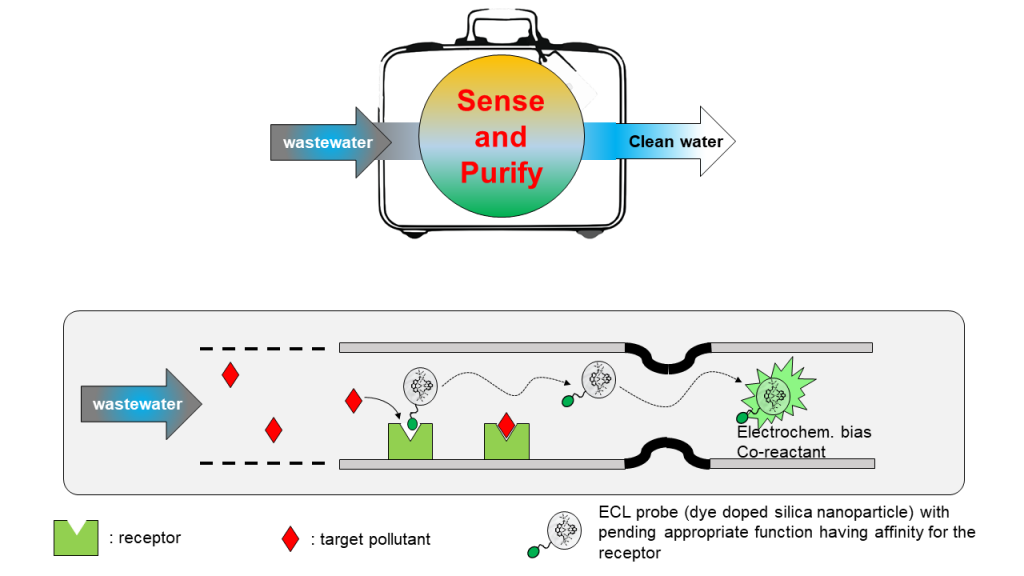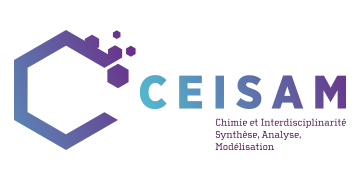Beaucoup de recherches sont menées dans le monde afin de développer de nouveaux matériaux à même de prendre en compte les problématiques actuelles liées à l’environnement. Dans ce contexte, deux directions sont explorées au sein de l’équipe IMF. L’une consiste à trouver des alternatives aux liants routiers issus de la chimie du pétrole, via des procédés utilisant des ressources renouvelables. L’autre s’intéresse à la mise au point d’un dispositif portable de purification pour l’élimination de polluants émergents dans les eaux usées.
Projet porté par Clémence QUEFFELEC et Bruno BUJOLI
Membres actuels : Ilef BORGHOL, Bruno BUJOLI, Clémence QUEFFELEC
In the context of recurrent petroleum-based bitumen supply issues, our pioneering work has recently demonstrated that hydrothermal liquefaction (HTL) of microalgae residues offered high potential for the production of sustainable road binders.
HTL consists in the treatment of the biomass using water as a solvent at temperatures and pressures varying from 200–400 °C and 5–20 MPa, respectively. We have thus shown that industrial extraction of water-soluble proteins on two types of microalgae (Scenedesmus sp. and Spirulina sp., respectively), led to wet residues that in both situations were successfully transformed by HTL in a black viscous material showing viscoelastic properties similar to that of traditional bitumen
We are currently investigating whether the production of biobinders might be also possible from other sources of low cost and largely abundant biomass wastes, in particular those which are yet poorly valorized.
In 2015, the consortium involved in this project was awarded the « Trophée de la Recherche Publique Energie-Environnement-Climat » from the ADEME Agency, to highlight the development of innovating technologies pour for the Environnement.

Collaborations:
- E. Chailleux (Université Gustave Eiffel, Bouguenais) ; UMR 6144 GEPEA, Nantes ;
- Algosource Technologies, Saint-Nazaire ; ITERG, Pessac ; CEA-LITEN, Grenoble ;
- Société Colas SA, Boulogne-Billancourt ;
- UMR 5256 IRCELYON, Lyon ;
- Eiffage Infrastructures Gestion et Développement, Vélizy-Villacoublay
Financements
- ANR PRCE AAP2016, « Algoroute » project (2016-2020).
- AAP ADEME / GRAINE 2016, « Bitume 2.0 » project (2017-2020).
Références
- E. Chailleux, M. Audo, B. Bujoli, C. Queffelec, J. Legrand, M. Paraschiv, M. Tazerout, O. Lépine, O., International patent : CNRS – Université de Nantes – IFSTTAR – ONIRIS – Ecole Des Mines De Nantes – Algosource, WO2015044891.
- Audo, M.; Paraschiv, M.; Queffelec, C.; Louvet, I.; Hemez, J.; Fayon, F.; Lepine, O.; Legrand, J.; Tazerout, M.; Chailleux, E.; Bujoli, B. Subcritical Hydrothermal Liquefaction of Microalgae Residues as a Green Route to Alternative Road Binders Acs Sustainable Chemistry & Engineering 2015, 3, 583.
- Borghol, I.; Queffelec, C.; Bolle, P.; Descamps, J.; Lombard, C.; Lepine, O.; Kucma, D.; Lorentz, C.; Laurenti, D.; Montouillout, V.; Chailleux, E.; Bujoli, B. Biosourced analogs of elastomer-containing bitumen through hydrothermal liquefaction of Spirulina sp microalgae residues Green Chemistry 2018, 20, 2337.
Projet porté par Yann PELLEGRIN
Agriculture uses large quantities of herbicides while industry generates significant volumes of waste water that is heavily polluted with organic contaminants. Similarly, effluents from hospitals contain significant amounts of pharmaceutical chemicals which end up in the water supply and can endanger the well-being of local fauna and flora as well as human health. For all these reasons, providing safe drinking water has become a huge worldwide concern, especially as regulations become more stringent. As clearly exposed in the introductive text of Accounts of Chemical Research special issue "Water for Two Worlds: Urban and Rural Communities”,1 “Business-as-usual approaches to producing safe drinking water […] will be inadequate to meet clean water needs in the 2000s. Technical advances in industrialized countries coupled with research focused on improving water access or water quality in lower and middle income (LMI) countries are rapidly converging and can provide leapfrog technologies for treating water that are moving toward increased decentralization of water treatment, which is capable of providing the highest quality water for drinking purposes and reuse of water for applications that require lower purity".
Traditional treatments mostly only concentrate toxins, producing residues that must be disposed of in landfills or incinerated. Importantly, usual methods prove inadequate to remove some emergent pollutants. Advanced Oxidation Processes (AOPs) are based on the generation from water and dissolved oxygen of highly reactive oxygen species, such as H2O2, O3, and in particular hydroxyl radicals OH●, that has an oxidizing power of 2.70 V vs. NHE, and is capable of mineralizing any organic compound.
The aim of this project is to design a portable device capable of treating wastewater locally, and able to assess the efficacy of the purification by measuring in close to real time the concentration of pollutants with bioassays. The purification step is performed by a wireless electrochemical method developed in the National Centre for Sensor Research (Dublin City University, Pr. R. Forster, coordinator of the project). The CEISAM is implied in the sensors development.
Sensors are based on electrochemiluminescence, namely the faculty to generate light in presence of an adequate luminescent probe, a reactant and an electrochemical bias. Several designs are envisioned, but in all situations a strongly luminescent probe is required. This is the main activity of the group, which collaborates with DCU for the full elaboration of the sensors. Our main aim is to use dye doped silica nanoparticles: 2 dyes are functionalized by alkoxysilane groups and co-condensed in presence of tetraethoxysilane. Depending of the conditions, small nanoparticles of controlled size can be obtained. Protected within the walls of silica, the immobilized dyes acquire enhanced emission quantum yields and lifetimes, and can be suspended in various media without the latter affecting the luminescence. Those advantages make them ideal probes for electrochemiluminescence as proven by numerous articles of the subject3.

Financial support:
Project SPY (JPI WATERWORKS, 2019-2022).
References
- Westerhoff, P.; Boyer, T.; Linden, K. Emerging Water Technologies: Global Pressures Force Innovation toward Drinking Water Availability and Quality. Acc. Chem. Res. 2019, 52, 1146-1147.
- Montalti, M.; Prodi, L.; Rampazzo, E.; Zaccheroni, N. Dye-doped silica nanoparticles as luminescent organized systems for nanomedicine. Chem. Soc. Rev. 2014, 43, 4243-4268.
- Valenti, G.; Rampazzo, E.; Biavardi, E.; Villani, E.; Fracasso, G.; Marcaccio, M.; Bertani, F.; Ramarli, D.; Dalcanale, E.; Paolucci, F.; Prodi, L. An electrochemiluminescence-supramolecular approach to sarcosine detection for early diagnosis of prostate cancer. Faraday Discussions 2015, 185, 299-309; Valenti, G.; Rampazzo, E.; Bonacchi, S.; Petrizza, L.; Marcaccio, M.; Montalti, M.; Prodi, L.; Paolucci, F. Variable Doping Induces Mechanism Swapping in Electrogenerated Chemiluminescence of Ru(bpy)(3)(2+) Core-Shell Silica Nanoparticles. J. Am. Chem. Soc. 2016, 138, 15935-15942; Bonacchi, S.; Genovese, D.; Juris, R.; Montalti, M.; Prodi, L.; Rampazzo, E.; Sgarzi, M.; Zaccheroni, N. In Luminescence Applied in Sensor Science; Prodi, L., Montalti, M., Zaccheroni, N., Eds.; Springer Berlin Heidelberg: Berlin, Heidelberg, 2011, p 93-138.
